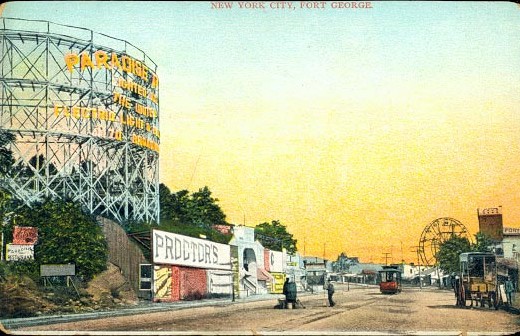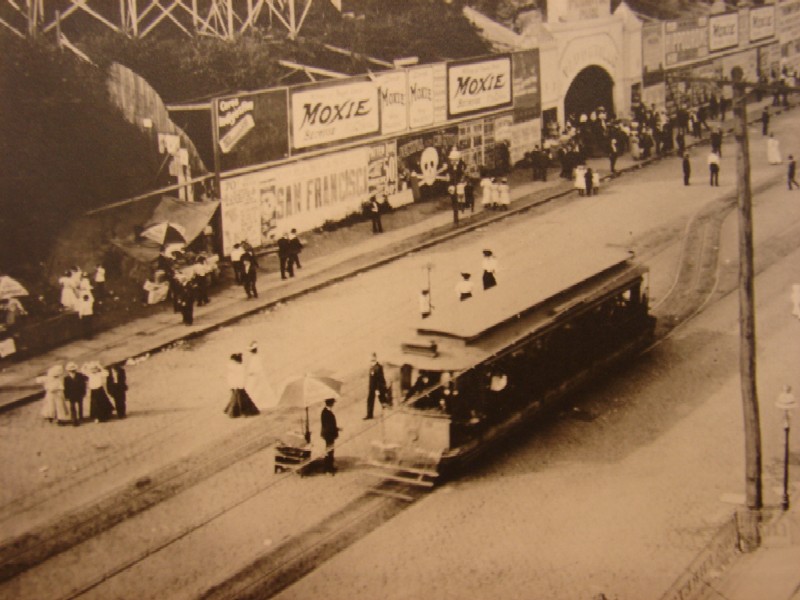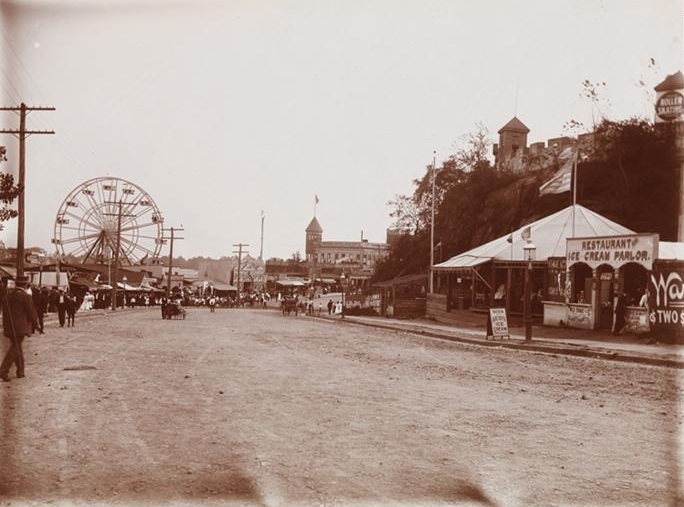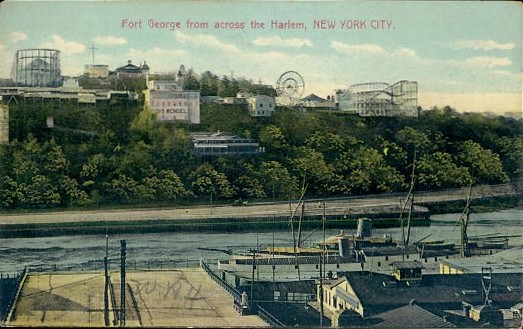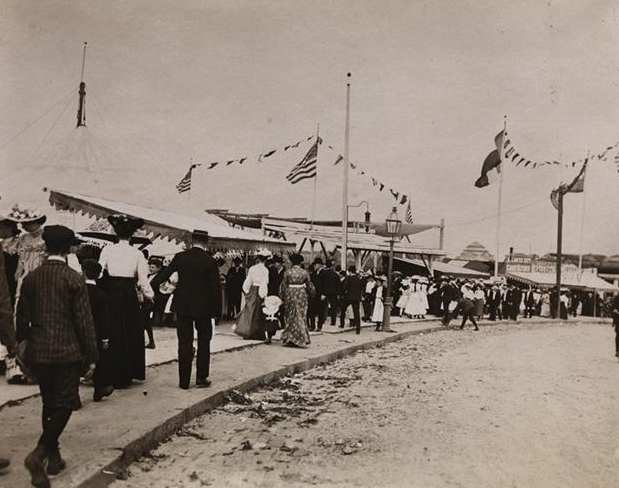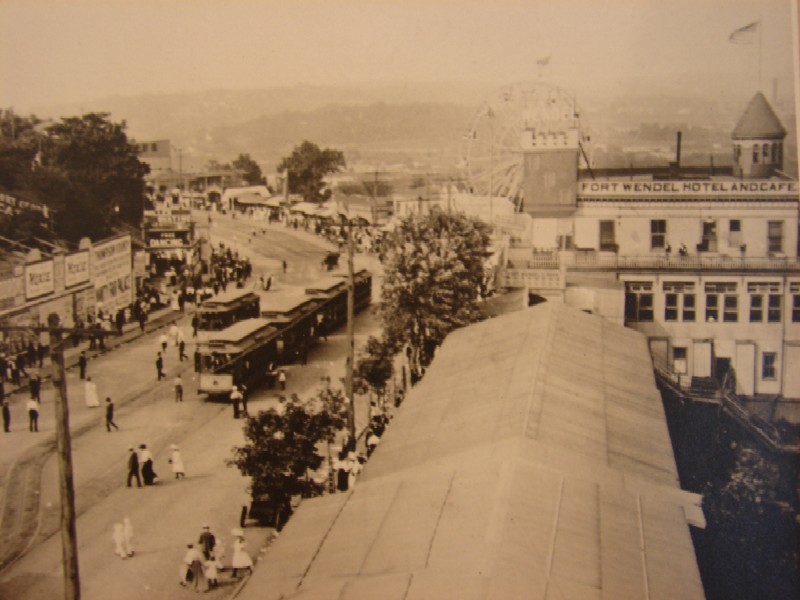In 1895, on the same spot where George Washington and his band of Revolutionaries defended a British assault after the Battle of Brooklyn, a glorious and magnificent amusement park rivaling Coney Island opened near the northeastern end of Manhattan. The Fort George Amusement park was located in what is now Highbridge Park between 190th and 192nd Streets and Amsterdam Avenue.
During its heyday this Gotham wonderland would boast two Ferris wheels, three roller coasters, nine saloons, a pony track, several hotels, a casino, five shooting galleries, a tunnel boat ride, two music halls called the Star and the Trocadero, fortune tellers and more frankfurters, peanuts and pretzels than you can imagine.
Located at the end of the Third Avenue Trolley line, the park was a natural and popular destination for locals and residents throughout the city. While the children rode the massive Ferris wheel or took to the Toboggan slide adults could gamble the night away before renting a room in the Fort George Hotel and Casino to celebrate their winnings, or more likely, mourn their losses. There were even areas in the park where, for a fee, Mom and Dad could drop the kids off in a supervised playground setting, while they went off to enjoy “The Human Ostrich” or “The Cave of Winds.”  Initially a loose and disorganized strip of sideshows the park became something truly spectacular under the leadership of Joseph Schenck (left) and his brother Nicholas. The brothers, Russian Jews who immigrated to New York from the ancient Slavic settlement of Rybinsk in 1893, first came to the park as curious visitors. Realizing the fortunes to be made they quickly invested in a beer hall called The Old Barrel.
Initially a loose and disorganized strip of sideshows the park became something truly spectacular under the leadership of Joseph Schenck (left) and his brother Nicholas. The brothers, Russian Jews who immigrated to New York from the ancient Slavic settlement of Rybinsk in 1893, first came to the park as curious visitors. Realizing the fortunes to be made they quickly invested in a beer hall called The Old Barrel.
It was in the Old Barrel that the Schnecks likely met another entrepreneur named Marcus Loew (right) , a park regular who had already amassed a small fortune with a string of theaters and penny arcades. (Loew would later become a Hollywood power-broker heading a theater chain that still bears his name.) Borrowing money from Loew, the brothers Schneck were soon able to open several thrill rides in an area of the park known as Paradise Park.
Marcus Loew (right) , a park regular who had already amassed a small fortune with a string of theaters and penny arcades. (Loew would later become a Hollywood power-broker heading a theater chain that still bears his name.) Borrowing money from Loew, the brothers Schneck were soon able to open several thrill rides in an area of the park known as Paradise Park.
In a June, 1941 edition of Liberty Magazine, found by New York Wanderer Ben Feldman while rummaging around in a Tennessee junk shop, details of the early days of the park begin to emerge:
“One hot Saturday afternoon in 1905, Joe Schenck, then about twenty-six, took a trolley ride up to Fort George, the highest point on Manhattan Island. That was quite the thing to do in those days–ride to the end of the car line up there to cool off. When Joe arrived he found more than a thousand other New Yorkers strolling about enjoying the breezes. He noticed that there were a beer parlor or two, a couple of shooting galleries, and some tintype stands, and he quickly concluded that this was insufficient entertainment for all those people. He began to talk to some of them, inquiring if they would come up nights, as well as Sundays, if Fort George offered a dance hall, a merry go-round, and other attractions like those at Coney Island. Everybody he questioned said “You bet!” or words to that effect.
Joe took a lease on a small one-story building at Fort George that could be reached only through an alley. He constructed a cheap dance floor in the rear and turned the building into a saloon. He hired an orchestra and an unknown singer named Nora Bayes, put tables around the dance floor, and then waited. But the people just wouldn’t go through the alley, not even through a big sign that proclaimed: “Beer and Dancing in Rear.”
What would be most likely to entice the public? It was brother Nick who suggested that a picture would be better than printed words. Joe hired a man who painted scenes on mirrors behind the bars to make a garish-colored wooden cutout of a huge beer schooner with the foam on the amber contents. The schooner, lighted up at night, could be seen from a distance, and it drew the thirsty in droves. The result was that by summer’s end Joe Schenck had cleaned up several thousand dollars.
Early in the spring of 1906 Joe and Nick began construction of what they called Paradise Park. On a Saturday afternoon in May, they were all set for the opening. They weren’t as enthusiastic as they might have been. After the merry-go-round and the other equipment had been installed, mostly on credit, they had realized, to their horror, that it would be necessary for the public to climb fifty-six steps to get to the park after leaving the trolley cars. They had been so engrossed in building the park on a high, cool spot that they had entirely overlooked that seeming drawback.
The brothers held their breath as the first of the Saturday-afternoon crowd began to spill out of their cars. When the visitors saw thhe amusements up there ahead of them, many were so eager that they took the fifty-six steps two at a time. The next day, Sunday, the same thing happened, and the Schencks knew that their fears about the steps had been unfounded. “And so,” Joe told me, “when we found the public didn’t mind the steps, we put a turnstile in–quick–right at the fifty-sixth step, and charged them ten cents admission. We hadn’t dared do that before.”
Some New Yorkers had such fond feelings for the park that it became a popular spot for wedding proposals. In fact, in June of 1907 nineteen-year-old Susan Pierce and Raymond Barrett went so far as to tie the knot on the skating rink where they met. The bride, bridegroom and minister all donned roller skates for the nuptials.
It was a first for the park and likely a first for New York. After exchanging vows some 500 couples joined Susan and Raymond on the rink to skate to the popular “Love Me and the World is Mine,” before the happy couple skated off to Atlantic City for their honeymoon.
But as the years passed, neighborhood sentiment towards the park soured.
Initially a boon for the local economy, local residents and real estate developers grew tired of the noise, the drunken crowds and the crime that came to be associated with the park.
 Then, on December 10th, 1911, an arsonist took public sentiment into his own hands and attempted to burn the park to the ground. According to news accounts high winds fanned the firebug’s torch destroying the Star Music Hall, the old Fort George Hotel, the dance hall of Paradise Park, a popular tavern and several smaller buildings. The damage, estimated at $25,000, could have been much worse if not for the daughter of truck farmer Nicholas Ceramer whose cries of “Papa, look at the fire,” allowed her father to sound the alarm. Ceramer emerged from his cottage across from the park just in time to “see a Man about 5 feet 9 inches tall, of stocky build, wearing a black hat and overcoat, run out of the lower floor of the music hall to the south. He gave chase, but failed to overtake the man.” Two years later, still healing from the scars of the arson attack the park suffered a fatal blow at the hands of another suspicious fire. On June 9th, 1913, a fire described as “the most spectacular ever seen,” engulfed the Fort George Amusement Park. At around two in the morning, Dominick Barnot, the night watchmen for Paradise Park saw that the dance hall was on fire. Barnot ran for help, but within ten minutes the fire, fueled by a strong westerly wind, had become an inferno. One-hundred foot flames seen as far south as 42nd Street were reported that night. Firemen and concerned volunteers descended on Fort George, but “the firemen quickly saw that it was their duty to save the property near by and let the park burn…One by one the play places were consumed. The roller coaster was quick to go, and then the Ferris wheel. And after the wheel the merry-go-rounds, the roller skating rink, and all the other things the Schneck Brothers had installed for the entertainment of the public.”
Then, on December 10th, 1911, an arsonist took public sentiment into his own hands and attempted to burn the park to the ground. According to news accounts high winds fanned the firebug’s torch destroying the Star Music Hall, the old Fort George Hotel, the dance hall of Paradise Park, a popular tavern and several smaller buildings. The damage, estimated at $25,000, could have been much worse if not for the daughter of truck farmer Nicholas Ceramer whose cries of “Papa, look at the fire,” allowed her father to sound the alarm. Ceramer emerged from his cottage across from the park just in time to “see a Man about 5 feet 9 inches tall, of stocky build, wearing a black hat and overcoat, run out of the lower floor of the music hall to the south. He gave chase, but failed to overtake the man.” Two years later, still healing from the scars of the arson attack the park suffered a fatal blow at the hands of another suspicious fire. On June 9th, 1913, a fire described as “the most spectacular ever seen,” engulfed the Fort George Amusement Park. At around two in the morning, Dominick Barnot, the night watchmen for Paradise Park saw that the dance hall was on fire. Barnot ran for help, but within ten minutes the fire, fueled by a strong westerly wind, had become an inferno. One-hundred foot flames seen as far south as 42nd Street were reported that night. Firemen and concerned volunteers descended on Fort George, but “the firemen quickly saw that it was their duty to save the property near by and let the park burn…One by one the play places were consumed. The roller coaster was quick to go, and then the Ferris wheel. And after the wheel the merry-go-rounds, the roller skating rink, and all the other things the Schneck Brothers had installed for the entertainment of the public.”
Down, but not defeated, the Schencks moved their act across the Hudson River, where they soon opened the wildly popular Palisades Park in New Jersey.
And, while Paradise Park was never rebuilt, a generation would remember the glory days and smile knowing they had witnessed a now forgotten piece of New York history. Click here to read more Inwood history.
